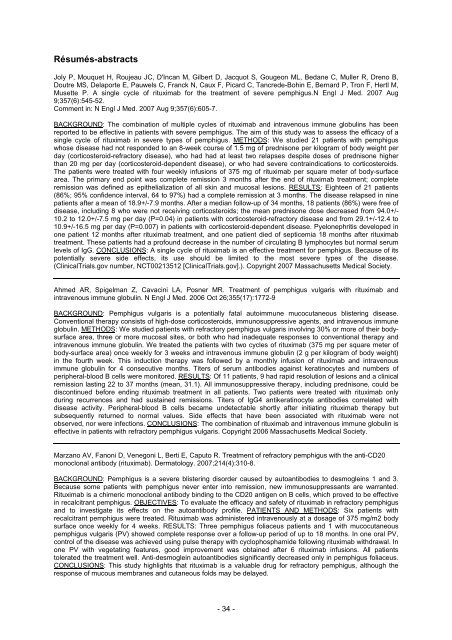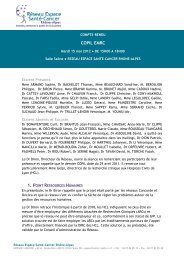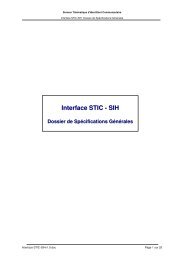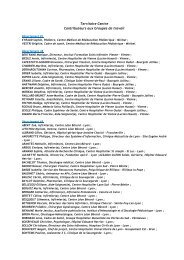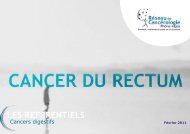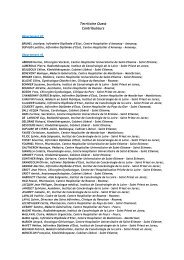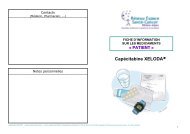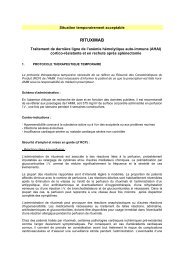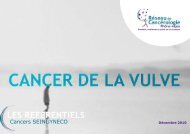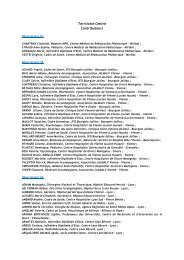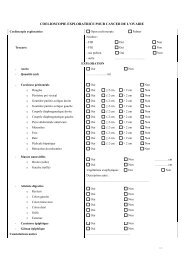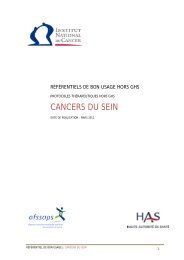rituximab
rituximab
rituximab
You also want an ePaper? Increase the reach of your titles
YUMPU automatically turns print PDFs into web optimized ePapers that Google loves.
Résumés-abstractsJoly P, Mouquet H, Roujeau JC, D'Incan M, Gilbert D, Jacquot S, Gougeon ML, Bedane C, Muller R, Dreno B,Doutre MS, Delaporte E, Pauwels C, Franck N, Caux F, Picard C, Tancrede-Bohin E, Bernard P, Tron F, Hertl M,Musette P. A single cycle of <strong>rituximab</strong> for the treatment of severe pemphigus.N Engl J Med. 2007 Aug9;357(6):545-52.Comment in: N Engl J Med. 2007 Aug 9;357(6):605-7.BACKGROUND: The combination of multiple cycles of <strong>rituximab</strong> and intravenous immune globulins has beenreported to be effective in patients with severe pemphigus. The aim of this study was to assess the efficacy of asingle cycle of <strong>rituximab</strong> in severe types of pemphigus. METHODS: We studied 21 patients with pemphiguswhose disease had not responded to an 8-week course of 1.5 mg of prednisone per kilogram of body weight perday (corticosteroid-refractory disease), who had had at least two relapses despite doses of prednisone higherthan 20 mg per day (corticosteroid-dependent disease), or who had severe contraindications to corticosteroids.The patients were treated with four weekly infusions of 375 mg of <strong>rituximab</strong> per square meter of body-surfacearea. The primary end point was complete remission 3 months after the end of <strong>rituximab</strong> treatment; completeremission was defined as epithelialization of all skin and mucosal lesions. RESULTS: Eighteen of 21 patients(86%; 95% confidence interval, 64 to 97%) had a complete remission at 3 months. The disease relapsed in ninepatients after a mean of 18.9+/-7.9 months. After a median follow-up of 34 months, 18 patients (86%) were free ofdisease, including 8 who were not receiving corticosteroids; the mean prednisone dose decreased from 94.0+/-10.2 to 12.0+/-7.5 mg per day (P=0.04) in patients with corticosteroid-refractory disease and from 29.1+/-12.4 to10.9+/-16.5 mg per day (P=0.007) in patients with corticosteroid-dependent disease. Pyelonephritis developed inone patient 12 months after <strong>rituximab</strong> treatment, and one patient died of septicemia 18 months after <strong>rituximab</strong>treatment. These patients had a profound decrease in the number of circulating B lymphocytes but normal serumlevels of IgG. CONCLUSIONS: A single cycle of <strong>rituximab</strong> is an effective treatment for pemphigus. Because of itspotentially severe side effects, its use should be limited to the most severe types of the disease.(ClinicalTrials.gov number, NCT00213512 [ClinicalTrials.gov].). Copyright 2007 Massachusetts Medical Society.Ahmed AR, Spigelman Z, Cavacini LA, Posner MR. Treatment of pemphigus vulgaris with <strong>rituximab</strong> andintravenous immune globulin. N Engl J Med. 2006 Oct 26;355(17):1772-9BACKGROUND: Pemphigus vulgaris is a potentially fatal autoimmune mucocutaneous blistering disease.Conventional therapy consists of high-dose corticosteroids, immunosuppressive agents, and intravenous immuneglobulin. METHODS: We studied patients with refractory pemphigus vulgaris involving 30% or more of their bodysurfacearea, three or more mucosal sites, or both who had inadequate responses to conventional therapy andintravenous immune globulin. We treated the patients with two cycles of <strong>rituximab</strong> (375 mg per square meter ofbody-surface area) once weekly for 3 weeks and intravenous immune globulin (2 g per kilogram of body weight)in the fourth week. This induction therapy was followed by a monthly infusion of <strong>rituximab</strong> and intravenousimmune globulin for 4 consecutive months. Titers of serum antibodies against keratinocytes and numbers ofperipheral-blood B cells were monitored. RESULTS: Of 11 patients, 9 had rapid resolution of lesions and a clinicalremission lasting 22 to 37 months (mean, 31.1). All immunosuppressive therapy, including prednisone, could bediscontinued before ending <strong>rituximab</strong> treatment in all patients. Two patients were treated with <strong>rituximab</strong> onlyduring recurrences and had sustained remissions. Titers of IgG4 antikeratinocyte antibodies correlated withdisease activity. Peripheral-blood B cells became undetectable shortly after initiating <strong>rituximab</strong> therapy butsubsequently returned to normal values. Side effects that have been associated with <strong>rituximab</strong> were notobserved, nor were infections. CONCLUSIONS: The combination of <strong>rituximab</strong> and intravenous immune globulin iseffective in patients with refractory pemphigus vulgaris. Copyright 2006 Massachusetts Medical Society.Marzano AV, Fanoni D, Venegoni L, Berti E, Caputo R. Treatment of refractory pemphigus with the anti-CD20monoclonal antibody (<strong>rituximab</strong>). Dermatology. 2007;214(4):310-8.BACKGROUND: Pemphigus is a severe blistering disorder caused by autoantibodies to desmogleins 1 and 3.Because some patients with pemphigus never enter into remission, new immunosuppressants are warranted.Rituximab is a chimeric monoclonal antibody binding to the CD20 antigen on B cells, which proved to be effectivein recalcitrant pemphigus. OBJECTIVES: To evaluate the efficacy and safety of <strong>rituximab</strong> in refractory pemphigusand to investigate its effects on the autoantibody profile. PATIENTS AND METHODS: Six patients withrecalcitrant pemphigus were treated. Rituximab was administered intravenously at a dosage of 375 mg/m2 bodysurface once weekly for 4 weeks. RESULTS: Three pemphigus foliaceus patients and 1 with mucocutaneouspemphigus vulgaris (PV) showed complete response over a follow-up period of up to 18 months. In one oral PV,control of the disease was achieved using pulse therapy with cyclophosphamide following <strong>rituximab</strong> withdrawal. Inone PV with vegetating features, good improvement was obtained after 6 <strong>rituximab</strong> infusions. All patientstolerated the treatment well. Anti-desmoglein autoantibodies significantly decreased only in pemphigus foliaceus.CONCLUSIONS: This study highlights that <strong>rituximab</strong> is a valuable drug for refractory pemphigus, although theresponse of mucous membranes and cutaneous folds may be delayed.- 34 -


